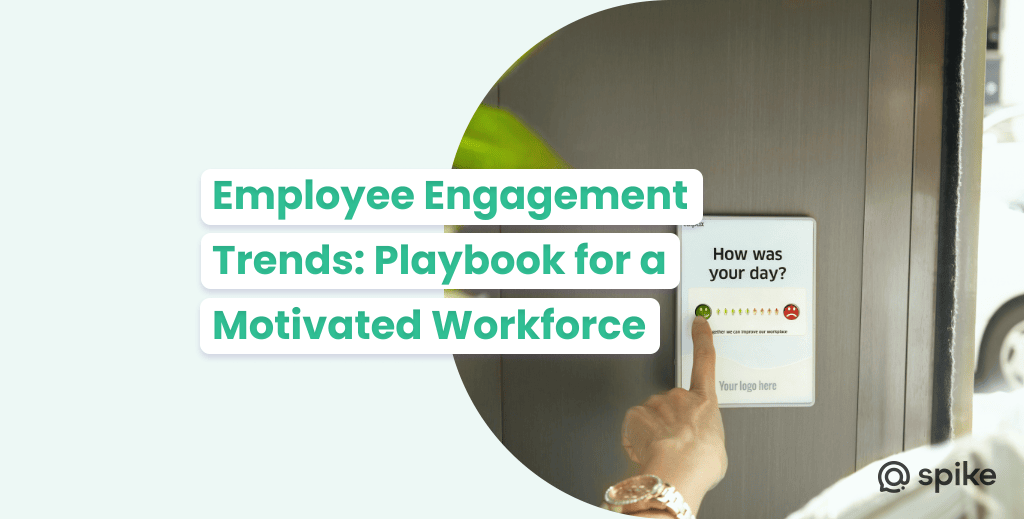Employee Engagement Trends: The 2023 Playbook for a Motivated Workforce

As business leaders, the importance of keeping employees engaged cannot be overstated. This integral component acts as the glue that keeps a well-oiled machine running smoothly. No longer is it simply a trendy term mentioned during high-level meetings; rather, it functions as the essential catalyst for productivity, ingenuity, and ultimately, the thriving of a business.
Passionate employees who are committed and willing to go the extra mile contribute to a successful organization. Employee engagement involves creating an environment where employees are motivated and involved in their work and organization.
In recent times, there has been a concerning trend. According to a Gallup poll, the majority of US employees do not feel genuinely engaged at work, which should be a wake-up call for businesses. It is imperative that they reevaluate their strategies and prioritize employee engagement once again.
Because engaged employees are more productive, it is important to understand why. They bring innovative ideas and are brand ambassadors for your organization. Moreover, they contribute positively to the company culture and are happier and healthier.
In this rapidly changing work landscape, employee engagement is taking on new dimensions. The traditional ways of fostering engagement no longer apply. The global pandemic has brought about a shift in employee priorities, adding complexity to our strategies. To stay ahead, we must adapt and find ways to keep pace. Let’s take a deep dive into the hottest employee engagement trends that will be popping up in 2023.
The Role of Employee Engagement Trends

In the pursuit of organizational growth, it is essential to keep employee engagement top of mind. It cannot merely be brushed off as another checked-off task on the list of a business leader. Instead, it serves as the fundamental pillar that upholds the entire company culture.
When employees are engaged, their productivity levels go up. This happens because engaged employees are motivated and motivated employees stay productive. Engaged employees are more likely to think creatively, put in extra effort, and think outside the box. All of these factors contribute to increased business growth. Keeping top talent within the organization is a challenge in this era of job-hopping, when remote work has made it easier than ever to move around. However, when employees feel engaged and connected, they are more likely to stay loyal to the company they’re at. The sense of belonging they have makes them reconsider before leaving. As a result, engagement plays a crucial role in employee retention.
Employee engagement also has a direct effect on the satisfaction of customers. When employees are engaged, they tend to prioritize providing exceptional customer service because they genuinely care about the company’s triumph. They grasp the importance of content customers in maintaining a prosperous business, which inspires them to actively contribute to that accomplishment.
Engagement contributes to a positive culture within the company. Happier employees boost the overall work atmosphere, resulting in a positive environment that benefits the entire organization. Consequently, this positive culture appeals to more talented individuals, leading to a cycle of engagement and achievement.
Employee engagement is a direct result of effective leadership. High engagement levels indicate that leaders effectively convey the company’s vision, make employees feel valued, and motivate their teams.
Top Employee Engagement Trends in 2023

1. People-first Culture
Creating a people-first environment is the bedrock for all employee engagement improvements. It involves establishing a culture where every team member feels acknowledged, appreciated, and recognized. Achieving this requires ongoing (and direct) communication, asking employee opinions, and, most importantly, taking action based on the feedback given. It also involves acknowledging the efforts of each individual and commemorating their accomplishments. A people-first culture goes beyond mere feel-good measures; it empowers employees to excel in their careers.
2. Flexibility and Work-life Balance
Today’s employee is increasingly seeking flexibility and a better work-life balance. This trend, which has been significantly accelerated by COVID-19, is not just about offering remote work options or flexible hours—it’s about acknowledging that employees have lives outside of work. It’s about respecting personal time and understanding that a well-rested and well-rounded employee is a more productive and engaged one. Leaders need to embrace this trend and create policies that support a healthy work-life balance.
3. Employee Health and Well-being
Companies prioritize the health and well-being of their employees. You must believe that taking care of our employees’ physical and mental health is essential for their overall happiness and productivity. From providing the necessary resources and tools for maintaining a healthy lifestyle to promoting work-life balance, leaders must be dedicated to creating a positive and supportive work environment.
A comprehensive benefits package includes should wellness programs, such as gym memberships, mental health counseling, and healthy meal options in our on-site cafeteria. Also, company-wide events and activities to encourage social interactions among colleagues and foster a sense of community. Making employee health and wellness a top priority is now more essential than ever. Businesses that want to boost engagement levels should provide comprehensive health insurance, offer wellness programs and mental health resources, and cultivate a culture that truly values wellbeing. It’s important to keep in mind that a productive and engaged employee is not only a happier one, but also a healthy one.
4. Fostering a Company Culture of Community and Connection
Creating a sense of unity and belonging among employees is important in meeting the needs of your team. It is vital to build a company culture that values community and fosters connections among your team. When employees feel a strong sense of belonging and connection with their colleagues, it can lead to improved employee morale, increased productivity (and profits), and a healthier work environment. Implementing team-building activities, encouraging open communication and collaboration, and recognizing and celebrating individual and team achievements are just a few ways to foster a culture of community and connection within an organization. By prioritizing these initiatives, companies can create a supportive and engaging work environment where employees feel valued and motivated to give their best.
5. Purpose-driven, Challenging Work that Aligns with Employees’ Values
In today’s work environment with highly integrated teams, it’s not only about the money for employees, especially those from the millennial and Gen Z generations. Finding meaning and a sense of alignment with personal values are key. As leaders, it’s your responsibility to provide work that goes beyond just being interesting and challenging – it needs to have a purpose. This means effectively sharing the company’s mission and values and demonstrating to employees how their contributions fit into the larger picture. When employees are committed to the mission of an organization, they’ll go beyond the minimum duties required to avoid getting fired or demoted.
6. Career Growth and Professional Development
Regular training sessions and mentoring programs are key drivers and indicators of employee engagement and support career growth. Employees desire to know that their organization is invested in their development and want to see a clear path to advancement. Recognizing when employees are prepared for new challenges and responsibilities is also important for their professional growth. Without a known path of progression in their career, they’ll likely get bored and start getting the minimum level of effort to their job.
7. Diversity, Equity, and Inclusion (DEI)
Diversity, Equity, and Inclusion in the workplace goes beyond mere compliance. It involves establishing a work atmosphere where all individuals feel appreciated and esteemed regardless of their background. A diverse workforce encourages diverse viewpoints and notions, which, in turn, can enhance progress and development and expose your strategies to different points of view. Likewise, an inclusive work environment nurtures a feeling of belonging, leading to heightened employee involvement. As company leaders, it’s your responsibility to guarantee that your DEI policies aren’t just empty statements but are actively put into practice and evident in your organizational culture and day-to-day activities. You don’t want to be left in a situation where negative grapevine communication hinders your culture.
Wrap-Up on Employee Engagement Trends
As we look ahead to the future of employee engagement in an evolving workplace, it’s clear that the landscape is shifting. The trends we’ve discussed—people-first culture, flexibility and work-life balance, employee health and well-being, fostering a sense of community, purpose-driven work, career growth and professional development, and DEI—are not just passing fads. They’re significant shifts that reflect the evolving needs and expectations of employees.
Embracing these trends is not just about staying relevant—it’s about fostering a work environment where employees feel valued, respected, and motivated to give their best. It’s about recognizing that your employees are your greatest asset, and their engagement is crucial to your success.
As you grow your business, aim to keep your fingers on the pulse of these trends, adapting our strategies as necessary to ensure that your engagement efforts are effective. You need to listen to our employees, understand their needs and expectations, and create an environment that not only meets but exceeds these expectations. In doing so, you’ll create an employee base that is engaged, committed, and motivated.
Gain Communication Clarity with Spike
You may also like
10 Strategies to Improve Time Management for Your Team
Boost your team's productivity and efficiency with these 10 effective strategies for improved time management.
Read More10 Ways to Encourage Idea Sharing in the Workplace
Want to create a workplace culture that values innovation? Check out these 10 effective ways to encourage idea sharing among your team members and boost productivity.
Read MoreFrom Cubicles to Couches: Is the Hybrid Workplace the Future?
Hybrid work—involving both remote and in-person tasks—increases productivity and flexibility at home while leveraging the social benefits of office gatherings
Read More



